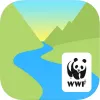Take a look inside 8 images
WWF Free Rivers
Pros: Great use of augmented reality; sights and sounds immerse students in the interesting and important topic.
Cons: Not a lot of depth, no teacher resources, very little interactivity.
Bottom Line: The free price tag makes this app a no-brainer for including in any lesson on water resources, though teachers will still need to provide context.
Start your lesson by talking about historical cultures that have benefited from free-flowing rivers, including their seasonal variations, such as the Nile Valley in Egypt. In what ways do cultures benefit from the river? Then talk with your students about dams. Ask them to name some. The Hoover Dam and the Grand Coulee Dam are two well-known examples. Discuss why the dams were built, and what benefits people receive in return. Then discuss what happens to the ecosystems behind the dam, as well as what happens downstream. Who is affected? How?
Next, introduce WWF Free Rivers. Go through the included story with students, and allow them to explore with their own classroom devices. Study the in-app maps and use the internet to dig deeper. Provide more context and background information as will fit into your lessons. If you want to extend this lesson, assign research projects on dammed areas or on areas that continue to be free-flowing and on the way those areas thrive (or don't thrive). What are the pros and cons of damming a river? What factors influence this?
WWF Free Rivers is an augmented-reality model app that takes students into a river ecosystem complete with animals, residents, cultures, and weather changes. The app includes a bit of a tour, taking students through a story of how river ecosystems are affected by building large dams, and how sustainably harvesting energy from the river is a better long-term solution. Students will also look more closely along the river system and learn about how people, animals, and the land itself are interconnected with the river and its behavior. They'll have the opportunity to move around the model on all sides, zoom in for a closer look, or back up to look at the whole system. The rainy season event of the app is quite immersive, and in all stages, students can move in closer to hear the rushing river and animal sounds.
After the river model story, there's a short mini-game that's almost an afterthought, where students navigate down the river on a raft, trying to hit blue dots. Students can also see world maps that show areas of water risk, world dams, protected areas, and wetlands. These come with larger animals (and a human) that can be studied from all sides.
WWF Free Rivers is a fascinating look at river systems and their health. It doesn't have a lot of depth, but what's there is interesting and educational. Students will learn how rivers affect people and wildlife, and in what ways humans depend on the rivers for survival. The importance of rivers and keeping them healthy is the focus. The immersive nature of augmented reality will keep students interested and exploring the river environment. The app would be greatly improved if students could interact with the river, placing dams in different areas and trying out their own options.

















